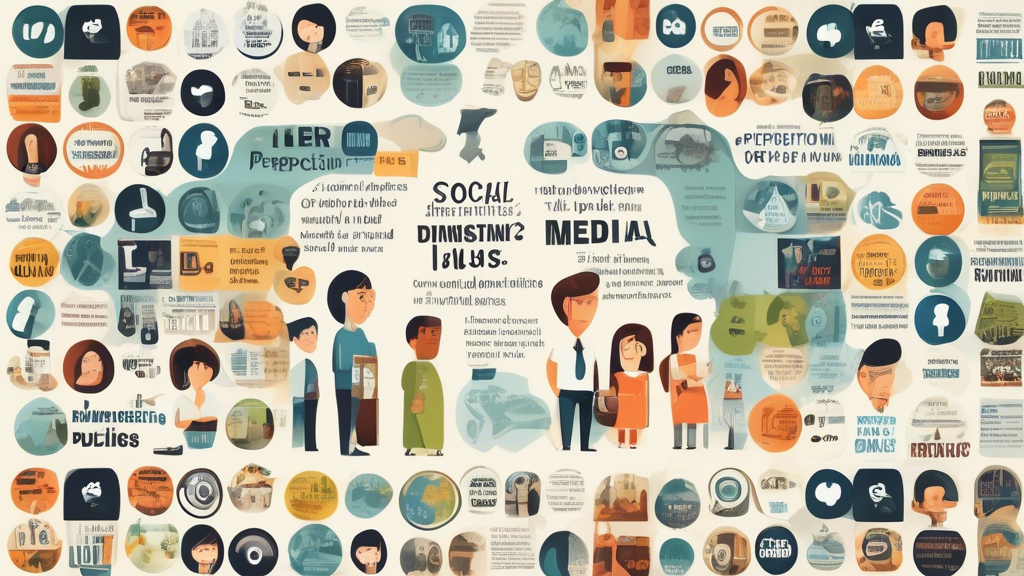Have you ever wondered how the public’s collective mindset can transform almost overnight? Public perception shifts are pivotal forces that have steered cultural norms, economic policies, and political landscapes throughout history. Think about the civil rights movement or the rise of the internet; each marked a significant turn in public perception, reshaping societies on a global scale. These historical shifts have not only altered cultural tides but have also influenced economies and political decisions in profound ways.
In today’s fast-paced world, factors like social media, technological advancements, and global events are accelerating these changes more than ever before. But what exactly contributes to such seismic shifts in public opinion now? Social media plays a huge role, offering a platform where ideas spread with the click of a button. Influential figures command sway, and major crises such as pandemics or climate change push the envelope further, altering public focus and belief systems.
Understanding these dynamics is vital for anyone looking to navigate the modern landscape. Businesses must adapt to remain relevant, political entities need to recalibrate to fit the evolving mindset, and anticipating future shifts is more crucial than ever. So, how does one keep a finger on the pulse of public perception? Let’s dive deeper to explore the driving forces behind this fascinating phenomenon and its implications for our nuanced world.
Introduction to Public Perception Shifts
Public perception, a critical force, shapes societal norms, beliefs, and behaviors. But what exactly is public perception, and why does it matter? Essentially, it’s the collective opinions and attitudes held by the general public about particular issues, entities, or events. Its significance is evident in how it influences decisions, from consumer choices to policy-making. Changes in public perception can alter the course of industries and governments alike.
History is ripe with examples of major shifts in public perception that left lasting impacts. Think about the civil rights movement in the 1960s. It revolutionized societal views on race, leading to transformative changes in laws and attitudes. Economic perspectives also underwent a shift during the Great Depression, as an entire generation learned the value of thrift and the need for social safety nets. Politically, the Watergate scandal changed how the public viewed government trust and transparency. These examples illustrate how shifts in perception can reshape culture, economy, and politics.
Today, we stand at a fascinating juncture where public perception is constantly evolving. Curious about what’s driving these changes? Several factors are at play. Social media, for one, acts as a powerful catalyst. It amplifies voices and speeds up the spread of information, fostering real-time changes in public sentiment. Global events, too, contribute significantly. Whether it’s a pandemic or a climate emergency, these crises force people to reassess priorities and beliefs. Technology plays a substantial role, as emerging innovations challenge and redefine existing perceptions daily.
As we delve further into understanding public perception shifts, we must consider both historical context and modern-day influences. How can we navigate these ever-changing waters effectively? Understanding the underlying trends and factors is crucial, providing a map to predict possible future shifts. Stay engaged as we explore this dynamic phenomenon and uncover its ramifications on the world stage.

Factors Influencing Public Perception Shifts
Have you ever wondered how quickly public opinion seems to change? One of the biggest culprits is digital media. With information at our fingertips, public perception shifts faster than ever. Let’s dive into the factors driving these changes.
Role of Digital Media and Information Accessibility
In the past, gathering information required effort and time. Now, in the digital age, news circulates globally within seconds. Social media platforms let everyone become a publisher, amplifying voices from diverse backgrounds. The abundance of content challenges traditional media’s monopoly on information. Curious about how this affects public thought?
Digital media enables rapid dissemination and consumption of information, shaping public opinion almost instantaneously. Trending topics can transform niche issues into mainstream discussions overnight. However, this accessibility comes with downsides: misinformation spreads just as quickly, skewing perceptions before facts are verified.
Consider the viral nature of social media. Have you ever seen a trending topic or hashtag and instantly formed an opinion? This phenomenon exemplifies the power of digital platforms in influencing public sentiment. Gone are the days of waiting for the evening news to inform and shape our perspectives.
Influence of Thought Leaders and Influential Figures
How often do celebrity endorsements impact purchasing decisions? In today’s online world, thought leaders influence more than just consumer habits. They steer public perception on critical issues too. Celebrities, activists, and experts, with significant followings, can sway public opinion through strategic posts and speeches.
Platforms like Twitter, Instagram, and TikTok amplify these voices significantly. Users follow influencers they trust, often adopting their perspectives without question. But can we always trust these voices? The clout wielded by influential figures holds power to unify or polarize opinions on a grand scale.
In many instances, a single tweet from a public figure can spark debates globally. Thought leaders excel at using emotional appeal to connect with followers. They often frame complex issues in relatable terms, making them accessible to broader audiences. Humor, passion, and relatability become powerful tools in their arsenal.
Impact of Global Crises on Public Perception
Global events like pandemics and climate change have profound impacts on our beliefs. Remember the early days of the COVID-19 pandemic? Public priorities shifted drastically as the world grappled with unprecedented challenges. Suddenly, health, hygiene, and community welfare took center stage.
Major crises act as catalysts for change, pushing societies to reassess values and priorities. The urgency of these issues demands action and often reshapes public perception swiftly. Does this mean we’re becoming more adaptable or just reactive?
Climate change, as another example, has forced many to reconsider their environmental impact. Increasingly, individuals prioritize sustainability, directly influencing consumer behavior and policy demands. Businesses align their practices with these shifts, some genuinely and some for optics, understanding the long-term benefits of mindful strategies.
The unpredictability of global events prompts businesses, governments, and citizens to adapt continually. We learn, evolve, and alter our perceptions in response to these external pressures. In a world where unforeseen events become more common, flexibility in public perception is not just an advantage—it’s a necessity.
So, what’s the takeaway? Digital media, thought leaders, and global crises are powerful forces driving public perception shifts. In a rapidly changing world, staying informed and adaptable becomes essential for navigating these swift currents.

Implications of Shifting Public Perception
How Businesses and Brands Adapt to Changing Public Perception
Why do some brands thrive while others fade into obscurity? The secret often lies in their ability to adapt to shifting public perception. Businesses must constantly monitor trends and consumer sentiments to stay ahead. This awareness ensures they can pivot their strategies, products, and services to align with current demand. For instance, embracing sustainability and ethical practices has become vital. Companies showcasing social responsibility in their campaigns tap into the growing consumer desire for ethical consumption. Humor me: When was the last time you saw a brand boasting about its carbon footprint?
Adapting involves rethinking marketing strategies, redesigning products, and even altering corporate philosophies. Brands that ignore public sentiment risk becoming obsolete. But those listening and responding can maintain customer loyalty and expand their market share. Can a brand really afford to ignore what its customers want? Consider tech companies that repeatedly release updates responding to user feedback—it’s not just good practice; it’s essential survival.
The Impact on Political Landscapes and Policymaking
How do public perception shifts tilt the political playing field? Politicians and policymakers are keenly aware of the public pulse. Shifts in public opinion can dramatically influence policy direction and political strategies. A strong connection exists between societal priorities and political agendas. When public perception evolves, politicians adjust their platforms to resonate with constituents’ current concerns. Take, for example, the increasing demands for action on climate change. As public anxiety grows, policymakers prioritize green policies, aligning governmental actions with constituent values.
Moreover, public opinion impacts election outcomes and party platforms. Politicians ignore shifting perceptions at their peril; doing so might lead to losing support or elections. A savvy politician incorporates public concerns into actionable policies, strengthening their political foothold. Why do you think seasoned politicians spend so much on focus groups and opinion polls?
Anticipating and Navigating Future Shifts
Is there a way to see the future? While no crystal ball exists, understanding trends in public perception offers predictive insights. Organizations and leaders equipped with this foresight can proactively adapt, creating strategies to navigate probable shifts. The art lies in monitoring emerging trends, cultural discussions, and technological advancements.
Analyzing social media conversations, studying demographic changes, and forecasting economic conditions help predict future shifts. With these insights, businesses and political entities refine their approaches to remain relevant. It’s a little like chess—each move considers the current state and potential future developments. Who would’ve guessed years ago that working from home would become the norm rather than the exception? Reading social and economic cues allows institutions to pivot seamlessly, transforming challenges into opportunities.
In essence, by playing close attention to public perception and remaining flexible, it’s possible to anticipate and smoothly navigate the complex landscape of evolving communal sentiments. An organization’s agility to respond effectively can mean the difference between leading an industry or falling behind.
Have you ever wondered how quickly public perception can change and reshape the world we live in? This article has explored the profound concept of public perception shifts, tracing its historical roots, current trends, and implications. In an age where information is at our fingertips and influential figures command substantial digital followings, these shifts are accelerating like never before.
From ancient cultural revolutions to today’s rapid-fire social media movements, public perception has always steered economies and politics, for better or worse. Now, social media and global crises catapult these shifts into hyperdrive, redefining what society values most. Remember when a single tweet could move markets or recalibrate a brand’s reputation overnight? The vigilance required from businesses and political entities in this landscape has never been more essential. They must listen, adapt, and anticipate—or risk falling from favor in the court of public opinion.
As we look towards the future, being aware of potential shifts is crucial. While one can never predict every twist and turn, understanding the mechanics behind public perception offers valuable foresight. It’s as if society is playing a high-stakes game of chess where awareness and adaptation are the keys to thriving. So, as you ponder the inevitable changes yet to come, consider how you’ll stay ahead in this ever-evolving world. Are you ready for the next big shift?
